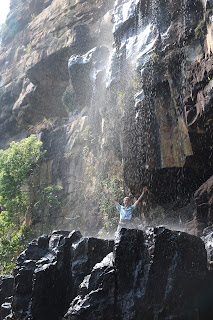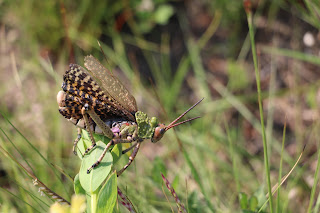The weather app was watched, and although not always to be relied
on this time it was correct and seeing it was going to be toasting day with
temperatures soaring into the thirties which would leave us all limp we decided
to be kind to ourselves and venture into the forest.
The forest would be our
last refuge at this moment as all the grassland in the reserve had been burnt
and flowers were on mass. The grassland would have been the priority in
its observations of what is flowering currently.
Everything has their
season and things can be so easily missed as could have been Clivia
miniata var. miniata which is one of our endemics. A
week ago they were only in bud and this week they were firing away in their in
magnificence. Since it is the week of Queen Elizabeth's II passing
it may be interesting to know that "Clivia” is named after the
Duchess of Northumberland, Lady Charlotte Clive, who first cultivated and
flowered the type of specimen in England. The species epithet
"miniate" means colour of red lead, referring to the
flowers.
Tea was held in the
chapel at Clearwater, the flowers of the Plumbago auriculata flowered in bridal
white edging the building that overlooked the most beautiful reserve. We then
meandered down observing the wildflowers and all the insects along the way that
were delighted in the joy of Spring. We cautiously navigated our way down
the steep path and into the forest. How different the world is under the
canopy of trees. It truly is quite magical. Tolkien and all the other
old-world stories were fairies and elves are mentioned are alive in this
forest. It has a great sense of peace and comfort and forests should be
protected as should all pristine environments.
Behind huge boulders lay
the secret in seeing these beautiful Clivia's which according to our dear
Maggie have depreciated over time and one can only speculate the reason being
through plant poachers. Having down some H.O. services and removing
invasive ferns we gently went on with the day. We found the rare Rinorea
domatiosa. This is only found in Pondoland in the understory of
an evergreen forest.
The group separated for
a while. Having heard a noise in the bush which could have been an
antelope Gail and Tracy ventured on and they found themselves amongst colossal
boulders and the scale could only be appreciated if one stands in the photograph
to see how miniscule one is. Lying on the forest floor Mimusops obovata calyx's
lay amongst Ochna petals and Rothmannia globosa flowers.
Hugging the wet slippery surfaces of the rock where the gentle waterfall fell
grew the delicate Utricularia livida with its pin-prick
leaves and tiny blue flowers. Debbie and Alf and joined and
found great pleasure in cooling off under the spray. It makes one feel as
if one is a child again with no worries and here one can simply be happy in
connecting with nature.
Tracy pointed out Chaetacme
aristate to Alf and Debbie in how it grew. This Thorny-elm which
is browsed by game and a larval food plant for butterflies can be very
confusing as its spines can be straight, single or paired and depending if it’s
it young or old the branchlets zig-zag in different manners.
Having set up the camera
to take a group photo Gail had once again found herself charging through Cyphostemma
rubroglandulosum, a Stinging-nettle, and when one looks at the leaf
one wishes one had brought one's razor along to give it a good shaving as it's
full of hairs and then one's tweezers so that one can do a lot of
plucking. Tongue in cheek Gail said to the H.O.s if we could please
remove the plant along with the invasive ferns that were growing comfortably
with the vulnerable Clivia's and came across a lot of shaking heads. Can
you believe that the Stinging-nettle is categorized as
"Rare".
The day was drawing to a close and along the path ascending up
onto the hot plains above we came across a little Night Adder who with yoga
breath defended its territory fiercely. We all left each other in peace
in the end and were grateful for the beautiful day.
 |
| Setting off to escape the heat and down into the forest. |
 |
| Flower mantis |
 |
| Eulophia hians var. hians ORCHIDACEAE  |
 |
| Rotheca hirsuta LAMIACEAE |
 |
| Graderia scabra Pink Ground-bells OROBANCHACEAE |
 |
| Tritonia gladiolaris IRIDACEAE |
 |
| Ursinia tenuiloba seed heads. |
 |
| Ursinia tenuiloba ASTERACEAE |
 |
| Hypoxis filiformis Grass Star-flower HYPOXIDACEAE |
 |
| Genlisea hispidula LENTIBULARIACEAE |
 |
| A Blue-headed Agama deciding which trail to take. |
 |
| Lasiosiphon kraussianus var. kraussianus Lesser Yellow-head THYMELAEACEAE |
 |
| Alf heading down through rocky terrain. |
 |
| Natalie on a bed of leaves cocooned by the sanctuary of the forest. |
 |
| Psilotum nudum Ferns PSILOTACEAE |
 |
| Cyphostemma rubroglandulosum Pondo grape VITACEAE Rare |
 Photo credit: Tracy | ||
|
 |
| Tracy enjoying every moment. |
 |
Alf enjoying the spray of the water fall. Water makes Debbie happy. |
 |
| Bachmannia woodii Four-finger Bush BRASSICACEAE Photo credit: Debbie |
 |
| Mimusops obovata calyx's Red- Milkwood SAPOTACEAE |
 | ||
| Chaetacme aristata Thorny Elm ULMACEAE
|
 |
| Causus rhombeatus Night Adder Dangerous |
 |
| Helichrysum nudifolium var. oxyphyllum ASTERACEAE |
 |
| Pondoland C.R.E.W. From centre: Anne Skelton, Debbie King, Alf Hayter, Tracy Taylor and Gail Bowers-Winters “Grief is the price we pay for love. When life seems hard, the courageous do not lie down and accept defeat; instead, they are all the more determined to struggle for a better future.” “I lived long enough to know that things never remain quite the same for very long.” - Queen Elizabeth II |










































































